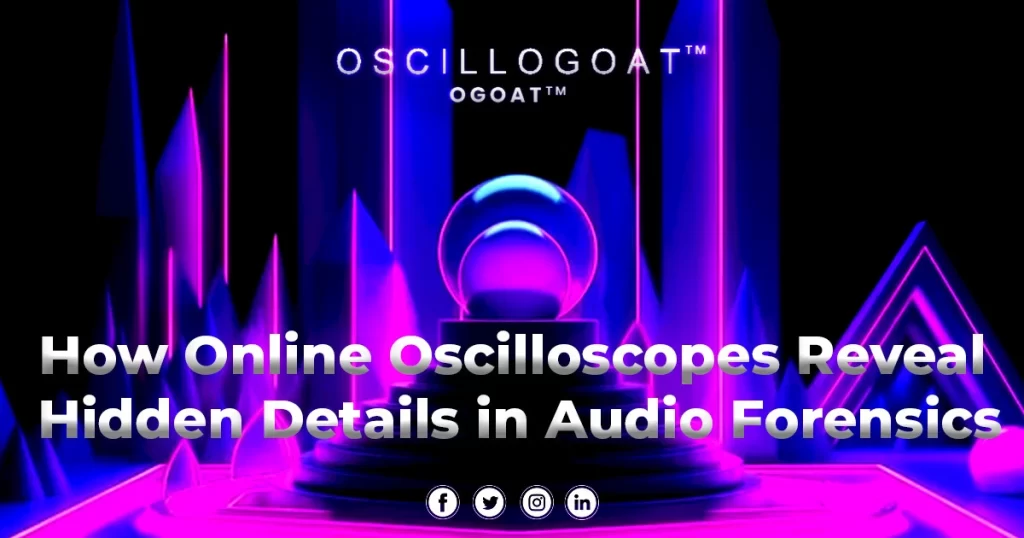
In the high-stakes world of audio forensics services, every whisper, every click, can hold the key to a case. But traditional methods struggle to extract the truth buried beneath layers of noise or manipulation. Crucial details can vanish, leaving investigators with an incomplete picture.
Online oscilloscopes are changing the game. They empower forensic teams to see the evidence by transforming sound into a visual map. They can spot edits, isolate faint sounds, and remove noise with unmatched precision.
With online oscilloscopes, the hidden details within recordings are laid bare, giving investigators the tools they need to crack the case.
Traditional Challenges in Audio Forensics
Traditionally, audio forensics has been a valuable tool for law enforcement and investigations. Analysts can utilize specialized software and hardware to perform tasks like speaker identification, noise reduction, and authenticity verification. However, despite these advancements, traditional methods face limitations when uncovering the intricacies hidden within a recording. Here’s a deeper look at these challenges:
Tampering
- The Elusive Edit: Audio manipulation techniques have become increasingly sophisticated. Splicing (inserting or removing segments), voice modification (altering pitch or timbre), and background noise insertion are all employed to create a deceptive narrative. Traditional methods might struggle to detect subtle edits, especially when dealing with high-quality recordings or manipulations performed by skilled individuals.
- The Blurring of Lines: Distinguishing between authentic audio and manipulated elements can be daunting. Traditional analysis might struggle to differentiate between original background noise and noise introduced during tampering, potentially leading to misinterpretations of the recording.
Environmental Noise
- A Symphony of Distractions: Recordings captured in real-world environments are often plagued by background noise – traffic, conversations, and machinery. These can easily mask crucial details within the recording. While attempting to isolate the desired audio, traditional filtering techniques can introduce distortion and artifacts, further hindering intelligibility.
- The Masking Effect: Low-level signals, like whispers or hidden messages embedded within the audio, can be easily drowned out by louder foreground elements. Traditional methods might not be able to adequately amplify and analyze these faint sounds, potentially leading to the loss of critical forensic evidence.
Enter the Online Oscilloscope
An online oscilloscope is a virtual version of the traditional electronic instrument visualizing electrical signals. In the context of audio forensics, these online tools convert audio signals into visual representations, offering a deeper level of analysis than relying solely on audio playback.
Benefits of Online Oscilloscopes in Audio Forensics
Let’s dive into the advantages online oscilloscopes offer, transforming how investigators see and dissect audio evidence.

Visualizing Tampering
By displaying the audio signal as a waveform, online oscilloscopes can reveal inconsistencies indicative of manipulation. Abrupt changes, unnatural patterns, or discontinuities in the waveform can point towards potential edits or splicing, aiding forensic investigators in identifying tampered recordings.
Noise Reduction with Granular Control
Unlike traditional filtering techniques that can introduce distortion, online oscilloscopes allow for precise control over noise reduction. By identifying specific frequencies associated with unwanted noise, investigators can selectively remove them while preserving the integrity of the original signal. This refined approach ensures crucial details remain clear for analysis.
Amplifying Faint Signals
Online oscilloscopes can magnify specific sections of the waveform, effectively amplifying faint sounds. This allows forensic investigators to analyze previously inaudible elements, such as whispers, hidden messages, or background sounds crucial for establishing context or identifying potential locations.
Collaboration and Accessibility
Online oscilloscopes are often web-based platforms, enabling remote access and collaboration. This facilitates communication and casework sharing among geographically dispersed forensic teams, fostering efficient investigation and analysis. Additionally, the cloud-based nature makes these tools readily accessible, eliminating the need for expensive hardware investments for smaller organizations.
The Future of Audio Forensics with Online Oscilloscopes
As technology advances, online oscilloscopes are expected to become even more sophisticated. Artificial intelligence (AI) integration could enable automated detection of anomalies and manipulation attempts, further streamlining the analysis process. Additionally, developing specialized online oscilloscopes tailored specifically for audio forensics could offer even more powerful and user-friendly features for investigators.
Conclusion
Online oscilloscopes are revolutionizing the field of audio forensics by providing a powerful tool to uncover hidden details and enhance analysis capabilities. By offering visual representations, precise noise reduction, and the ability to amplify faint signals, these tools empower investigators to unlock the secrets hidden within audio recordings, bringing us closer to the truth in complex forensic cases.
